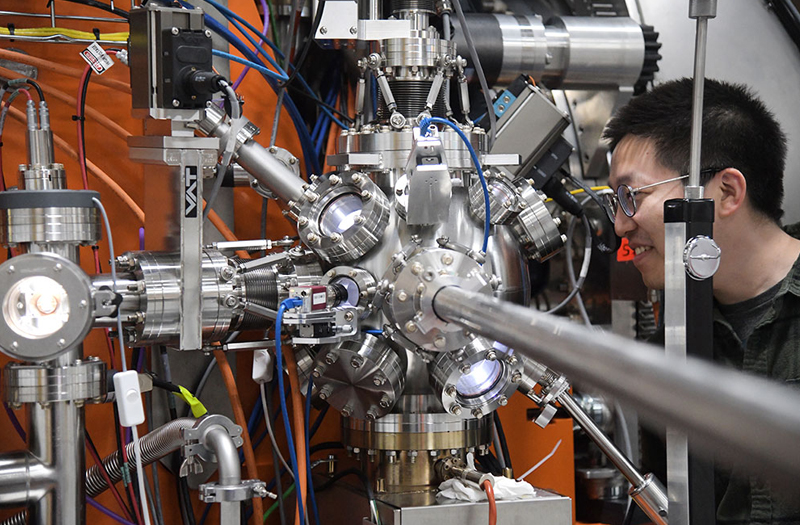
“Spot the difference” games are common in children’s magazines. These puzzles present two images that are nearly identical with subtle differences. Researchers at the Department of Energy’s Brookhaven National Laboratory took a similar tactic when comparing two types of high temperature superconductors. By comparing and contrasting them, they hope to understand what properties make these materials different from conventional superconductors.
Superconductors are materials that electricity can move through without losing energy to heat. In normal conducting materials like metal, electrons repel each other. As the electrons move through a metal, they do so chaotically. The metal conducts electricity imperfectly and loses energy to heat. In superconductors, electrons overcome their repulsion and pair up. Like children walking in two-by-two lines, they move through the metal smoothly.
Superconducting materials could enable new technologies. Having electrical wires made of superconducting material could enable a very efficient electrical grid. About 5 percent of electricity is lost as heat during transmission and distribution. Superconducting technology could significantly reduce energy use and greenhouse gas emissions. These materials could also enable computers that don’t need energy-intensive cooling.
Unfortunately, there’s a major hitch. While many materials can become superconducting, they only do so at temperatures close to absolute zero (-460 degrees F). Despite these limits, we use superconductors in certain technologies, like MRIs and particle accelerators. But generally, the need for cooling limits potential applications for superconductors. It also wipes out the energy efficiency improvements they could offer.
High-temperature superconductors are a little different. “High temperature” may evoke images of the desert. But in the case of superconductors, it means “not incredibly close to absolute zero.” They still only function at temperatures lower than -300 degrees Fahrenheit. But the fact that these materials are different from conventional superconductors offers some possibility that room-temperature superconductors could exist.
One class of high-temperature superconductors is based on copper; another is based on nickel.
Scientists discovered copper-based superconductors in the 1980s. Since then, they’ve been working to figure out their unique characteristics.
After discovering copper-based superconductors, scientists realized it could be useful to study similar materials. Nickel seemed like an obvious choice. Because it’s near copper on the Periodic Table, it was likely that compounds made with nickel could behave in a similar way to those made with copper. Researchers at Stanford University developed a nickel-based superconductor in 2019.
To dig into the similarities and differences, researchers at DOE’s Brookhaven National Laboratory leveraged the power of the National Synchrotron Light Source-II (NSLS-II). Scientists use the NSLS-II’s X-ray light to peer into the structures, properties, and chemistry of materials at extremely small scales. The specific beamline allowed the scientists to tweak the X-ray energy to focus on individual elements in the sample. That ability allowed them to examine just the oxygen, the nickel, the copper, or other elements.
The scientists wanted to know which electrons in which elements contribute to superconductivity. Past research showed that superconducting behavior in the copper-based materials is related to how the copper ions interact magnetically. The researchers thought that the nickel ions might interact the same way.
The researchers also wanted to explore a feature called a charge density wave. Charge density waves are specific patterns of electrons that come up in materials that are consistently ordered and form crystals. Scientists have hypothesized that charge density waves are related to superconductivity. By examining which electrons lead to the charge density waves, they aimed to get a firmer handle on the waves’ role.
The scientists found that the copper-based and nickel-based materials were similar but had key differences. In both materials, the interactions between the copper or nickel and oxygen influenced electron movement. But in the nickel-based material, the influence was weaker.
The scientists also found that the charge density wave in the nickel-based material was much more complex than in the copper-based one. In the copper-based one, the charge density wave came from interactions between the copper and oxygen. In contrast, the charge density wave in the nickel-based one came from interactions among all the different elements.
These results increase our understanding of these intriguing materials. With this information, scientists may be able to tweak nickel-based superconductors to change their properties. These insights also help scientists better understand other quantum materials where electrons interact strongly.
It’s been more than 100 years since the physicist Heike Kamerlingh Onnes and his team discovered superconductivity. Every investigation into understanding these promising materials brings us closer to being able to use them to make our world more sustainable and efficient.
Official news published at https://www.energy.gov/science/articles/investigating-high-temperature-superconductors

